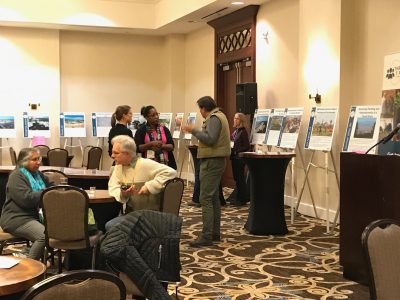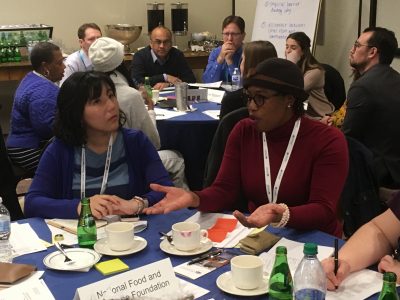By Sarah Wilkins
Attendees at Fall Meeting this year were greeted with the question: “What will you discover?” Between local field trips, AGU TV, e-lightning sessions and talks featuring cutting edge Earth and space science research, attendees had vast opportunities to discover new ideas and perspectives across many disciplines. The TEX team was no exception. Across our four events and the numerous sessions and receptions we attended, TEX made an exciting new discovery of our own: Community science has hit an inflection point and we are now seeing an inspiring groundswell of support and interest in this kind of work.
Exciting, right? We certainly think so. This blog post highlights our experiences at Fall Meeting and the stories that illustrate how community science is making big waves in the Earth and space science community.
Kicking Off Fall Meeting
 We kicked off Fall Meeting with a brand-new Science to Action workshop, Practical Tips and Real-World Strategies for Engaging with Communities. Fondly referred to as “Community Science 101” among our team, this workshop combined both lecture and interactive activities (including a role play component!) to teach participants our key tips and strategies for building and carrying out successful community science projects. The role play component had scientists at each table pretending to be community leaders by following a few prompts and a script. It wasn’t the stellar role-playing skills that blew us away with this workshop, but rather the outstanding attendance for our event. Ten minutes after the scheduled start time, we found ourselves dragging in 15 extra chairs to accommodate workshop participants. At the end of the event, a couple of graduate students approached me to express their interest and eagerness to get involved with more community science projects. One graduate student stopped to say how excited she was to be able to take advantage of these resources at Fall Meeting and inquired about other ways to get involved in community science projects. I was encouraged to see so much interest in community science among students motivated to pursue this type of science in their careers.
We kicked off Fall Meeting with a brand-new Science to Action workshop, Practical Tips and Real-World Strategies for Engaging with Communities. Fondly referred to as “Community Science 101” among our team, this workshop combined both lecture and interactive activities (including a role play component!) to teach participants our key tips and strategies for building and carrying out successful community science projects. The role play component had scientists at each table pretending to be community leaders by following a few prompts and a script. It wasn’t the stellar role-playing skills that blew us away with this workshop, but rather the outstanding attendance for our event. Ten minutes after the scheduled start time, we found ourselves dragging in 15 extra chairs to accommodate workshop participants. At the end of the event, a couple of graduate students approached me to express their interest and eagerness to get involved with more community science projects. One graduate student stopped to say how excited she was to be able to take advantage of these resources at Fall Meeting and inquired about other ways to get involved in community science projects. I was encouraged to see so much interest in community science among students motivated to pursue this type of science in their careers.
 Later that evening, we found our way over to the Hilton’s ballroom to host our 4th annual TEX reception. Displayed around the room were 51 posters highlighting new and old TEX projects. Attendees could read about the diversity of TEX projects, from modeling water availability in Ethiopia to mapping heat vulnerability in Montana. As we enjoyed a beverage and some hors d’oeuvres, our team observed an enthusiastic crowd. We were also excited to see how many students and early career scientists were talking to and connecting with who we consider “seasoned community science practitioners.” One of the 101 attendees, a hydrology graduate student from Colorado State University, attended the reception and told me how empowering it was to see organizations like AGU connecting science to new communities and how this will ease the way for her involvement in this type of science post-graduation. There is so much knowledge and wisdom to be shared from the wealth of experience within this community and it was inspiring to see so many people talking animatedly, reading the TEX posters and asking each other about their experiences in community science. Meanwhile, a veteran TEX scientist from our Denver project met up with a newer TEX scientist from the Louisville project to trade tips and ideas on how to do air quality projects with environmental justice communities.
Later that evening, we found our way over to the Hilton’s ballroom to host our 4th annual TEX reception. Displayed around the room were 51 posters highlighting new and old TEX projects. Attendees could read about the diversity of TEX projects, from modeling water availability in Ethiopia to mapping heat vulnerability in Montana. As we enjoyed a beverage and some hors d’oeuvres, our team observed an enthusiastic crowd. We were also excited to see how many students and early career scientists were talking to and connecting with who we consider “seasoned community science practitioners.” One of the 101 attendees, a hydrology graduate student from Colorado State University, attended the reception and told me how empowering it was to see organizations like AGU connecting science to new communities and how this will ease the way for her involvement in this type of science post-graduation. There is so much knowledge and wisdom to be shared from the wealth of experience within this community and it was inspiring to see so many people talking animatedly, reading the TEX posters and asking each other about their experiences in community science. Meanwhile, a veteran TEX scientist from our Denver project met up with a newer TEX scientist from the Louisville project to trade tips and ideas on how to do air quality projects with environmental justice communities.
 Wednesday featured our all-day Project Launch Workshop. Seasoned community science practitioners facilitated the launch of seven new projects, working with scientists and community leaders representing parishes across coastal Louisiana, neighborhoods of New Orleans, and remote islands in Alaska. Each table was focused on a community–crowded with eager AGU scientists. We emphasized active listening, creative thinking, and the value of traditional and local knowledge. After the workshop ended, I spoke with the community leaders from Claiborne Reborn, a neighborhood community group organizing to reverse environmental pollution and cultural degradation attributed to a freeway that cuts through their neighborhood. These women mentioned that the workshop inspired them to think about science in a new way – they had never thought about science as part of the solution to their community challenges. It was so heartening to hear this, because it highlights the potential of community science to increase trust from non-scientists in the scientific methods.
Wednesday featured our all-day Project Launch Workshop. Seasoned community science practitioners facilitated the launch of seven new projects, working with scientists and community leaders representing parishes across coastal Louisiana, neighborhoods of New Orleans, and remote islands in Alaska. Each table was focused on a community–crowded with eager AGU scientists. We emphasized active listening, creative thinking, and the value of traditional and local knowledge. After the workshop ended, I spoke with the community leaders from Claiborne Reborn, a neighborhood community group organizing to reverse environmental pollution and cultural degradation attributed to a freeway that cuts through their neighborhood. These women mentioned that the workshop inspired them to think about science in a new way – they had never thought about science as part of the solution to their community challenges. It was so heartening to hear this, because it highlights the potential of community science to increase trust from non-scientists in the scientific methods.
 The next day, our team hosted a focused workshop to crowdsource ideas for the forthcoming redesign of the roof of the Ernest N. Morial Convention Center—the site of this year’s Fall Meeting! The workshop encouraged geoscientists to think creatively about how infrastructure can advance resilience and sustainability through brainstorming new options for the Convention Center roof. The workshop not only attracted Fall Meeting attendees, but engineers and operations managers for the Convention Center and local architects too. On the way out the door, our director, Raj Pandya, heard from one of the architects that she was surprised to find that scientists can indeed be more creative than architects! To continue the theme of students inspired by community science, a junior studying Earth System Science at the University of Alabama gave a report out on his table’s brainstorm session and said about his experience, “I am extremely passionate about creating change in communities…and implementing solutions to gain sustainability.”
The next day, our team hosted a focused workshop to crowdsource ideas for the forthcoming redesign of the roof of the Ernest N. Morial Convention Center—the site of this year’s Fall Meeting! The workshop encouraged geoscientists to think creatively about how infrastructure can advance resilience and sustainability through brainstorming new options for the Convention Center roof. The workshop not only attracted Fall Meeting attendees, but engineers and operations managers for the Convention Center and local architects too. On the way out the door, our director, Raj Pandya, heard from one of the architects that she was surprised to find that scientists can indeed be more creative than architects! To continue the theme of students inspired by community science, a junior studying Earth System Science at the University of Alabama gave a report out on his table’s brainstorm session and said about his experience, “I am extremely passionate about creating change in communities…and implementing solutions to gain sustainability.”
What’s Next for Community Science and TEX?
Throughout Fall Meeting, community science was abuzz. Everywhere our team looked, TEX found enthusiasm for community science and its principles. Raj was inspired when he stepped into a public affairs session where the speakers were talking about science co-creation and co-generation. Melissa was encouraged to see the number of students that attended multiple TEX events and approached her during her poster session on the Resilience Dialogues. Natasha received multiple emails from students looking to find more community science opportunities. Even our TEX advisory board members picked up on the great attendance across all our events.
As we close out 2017, it’s important to stop and reflect on this year’s progress. It’s inspiring to see community science reach this inflection point, and know that TEX was part of it. They say that Rome wasn’t built in a day, and neither was community science. Trust—the foundation of community science—takes time to build, and so does growing a movement. We’re heartened by the commitment and eagerness shown by scientists and community leaders alike to expand community science. Will you join us in this effort?

